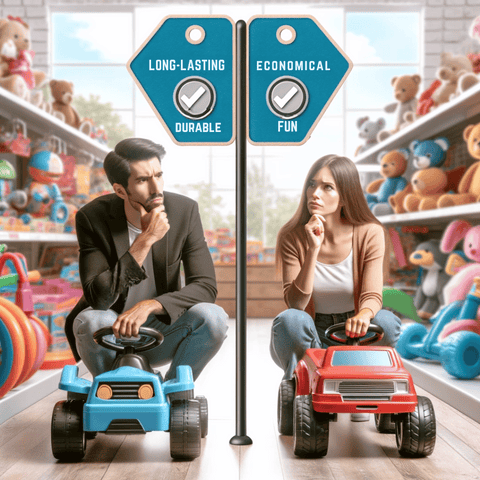
Updated: 28.4.25
Ride-on toys are more than just playthings—they're milestones in childhood development, fostering motor skills, independence, and unforgettable memories. Understanding how long these toys typically last—and how to extend their lifespan—is essential for parents, guardians, and childcare providers.
In this guide, we'll explore what affects ride-on toy longevity and share essential maintenance tips to keep them rolling longer.
Understanding the Basics of Ride-On Toy Longevity
Not all ride-on toys are built the same. Their durability is shaped by materials, manufacturing quality, type (manual vs. battery-powered), and how they’re used and cared for.
Related: Knowing When to Replace Worn Parts on a Kid’s Electric Ride-On Toy
Factors Affecting Lifespan
Several factors influence ride-on toy durability, including design quality, usage environment, and maintenance habits. Sturdy frames and high-grade materials always perform better over time.
Maintenance and Care Essentials
Proper care extends the toy's life—it’s that simple. Focus on these key areas:
Battery Maintenance
For battery-powered models, good battery habits are critical. Charge after use, avoid overcharging, and store the toy somewhere cool and dry.
Routine Safety Checks
Inspect brakes, wheels, and structural elements regularly. Early repairs prevent bigger, costlier issues later on.
Cleaning and Proper Storage
Keep toys clean with a soft cloth. Always store them away from direct sunlight, moisture, and extreme temperatures to avoid material damage.
Smart Usage Tips
Encourage use on flat, smooth surfaces. Avoid gravel, puddles, or rough terrain unless the toy is designed for it.
Replacement Parts and Upgrades
Don't junk a ride-on at the first sign of wear. Replacement wheels, batteries, and steering components can give it a second life.
Safe Use Means Longer Life
Teach Safe Driving Habits
Steer children away from collisions and rough play to protect both the toy and the rider.
Supervision for Toddlers
Close supervision prevents misuse that could shorten the toy’s life—and keeps toddlers safer.
Follow Toy Safety Standards
Choose toys that meet recognised safety certifications—they’re often built to last longer, too.
Respect Weight Limits
Overloading a ride-on toy is a fast track to cracked frames and broken motors. Stick to the manufacturer's limits.
Why Regular Maintenance Matters
A toy that's cleaned, inspected, and properly stored can last two or three times longer than one that's neglected.
Choosing Durable Ride-On Toys
Invest in ride-ons made with reinforced plastic or metal frames, reputable battery systems, and models suited to your child's weight and age group.
Common Issues & Easy Fixes
From loose bolts to flat tyres, small issues are often easy DIY fixes. Knowing basic troubleshooting can save you money and extend toy life.
Related: Kids Ride on Toy Buyers Guide
Professional Maintenance and Repair
Sometimes, it’s smart to call in the pros. Complex electrical faults, frame repairs, or parts upgrades can often be handled more safely by an expert.
Recycling and Disposal Tips
When it’s truly time to say goodbye, check your local recycling rules. Many ride-on toys have recyclable plastics and batteries that shouldn't go into regular trash bins.
Conclusion
Ride-on toys can last many happy years when properly chosen, maintained, and stored. Focus on quality, care, and smart usage to maximise the life—and fun—your child gets out of their favourite wheels.
FAQs
Can the type of battery affect how long a ride-on toy lasts?
Absolutely. Higher quality batteries offer longer life and better performance. Always use the manufacturer-recommended type.
How does frequent use impact durability?
Daily use leads to faster wear, but proper maintenance can drastically reduce the effect.
Is it worth repairing an old ride-on toy?
Minor repairs are often worthwhile, but if repair costs rival replacement prices, it’s smarter to invest in a new model.
Does the material of the toy matter?
Definitely. Toys built with heavy-duty plastic or metal frames tend to last much longer than those made from lightweight materials.
Get in Touch 🚀
Loved our article on “How Long Do Ride-On Toys Last?”? Ready for more wheely-awesome fun?
Visit RiiRoo.com or start a Live Chat with our team. We’re here to answer all your ride-on toy questions!







Share:
What Is The Difference Between The John Deere Style Tractor and Trailer Big 12V and the RiiRoo JDX Tractor with Trailer
What Is The Difference Between The OneQuad 2021 PX3S 110cc Petrol and the OneQuad EX1S 1000w Electric Quad Bike